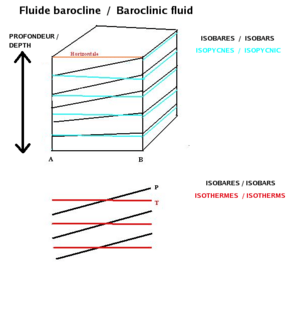Baroclinic facts for kids
Baroclinicity (say: bah-roh-KLIN-ih-sih-tee) is a scientific term that helps us understand how the air around us moves and creates weather. Imagine the air as a giant fluid, like water in a swimming pool. Baroclinicity tells us how "mixed up" this fluid is, especially when its temperature and pressure change in different ways. It's super important for understanding things like storms and how weather fronts form.
Contents
What is Baroclinicity in Weather?
In the world of fluid dynamics, which is the study of how liquids and gases move, baroclinicity is a way to measure how different layers of a fluid are arranged. Think of it like a layered cake where each layer has a different density. In our atmosphere, density is how much "stuff" is packed into a certain amount of space.
When we talk about a baroclinic atmosphere, it means the air's density depends on both its temperature and its pressure. This is a bit like saying that if you have a hot, light air mass next to a cold, heavy air mass, they will want to move and mix. This mixing is what often leads to interesting weather.
Baroclinic vs. Barotropic
To understand baroclinicity better, it helps to compare it with its opposite: barotropy.
- Baroclinic atmosphere: Here, the air's density changes because of differences in both temperature and pressure. Imagine lines on a weather map showing areas of equal pressure (called isobars) crossing over lines showing areas of equal temperature (called isotherms). When these lines cross, it means there's a baroclinic situation. This crossing creates forces that make the air move, leading to winds and storms.
- Barotropic atmosphere: In this type of atmosphere, the air's density depends only on its pressure. This means the temperature is pretty much the same across areas of equal pressure. When isobars and isotherms run parallel to each other, it's a barotropic situation. In these areas, the air tends to move more smoothly and predictably, often without forming strong storms.
Where Does Baroclinicity Happen?
Baroclinic conditions are usually found in specific parts of the Earth.
- Mid-latitude and Polar Regions: These are the areas between the tropics and the poles, like where most of the United States, Europe, and Canada are located. Here, cold air from the poles often meets warm air from the tropics. This clash of different temperatures and pressures creates strong baroclinic zones. These zones are where most of our major weather systems, like big storms and weather fronts, are born.
- Tropical Regions: In contrast, the tropical zones (near the Earth's equator) are generally more barotropic. The temperature changes less dramatically across these regions, so the air density is mostly influenced by pressure. This is why tropical weather tends to be more consistent, with less dramatic shifts than in the mid-latitudes.
How Baroclinicity Affects Weather
The interaction of temperature and pressure differences in a baroclinic atmosphere is crucial for creating many weather phenomena.
- Storms and Cyclones: Baroclinicity provides the energy for storms to develop and grow. When warm, moist air meets cold, dry air, the density differences create a "tilt" in the atmosphere. This tilt can lead to the formation of swirling low-pressure systems, also known as cyclones or storms.
- Weather Fronts: You've probably heard of cold fronts and warm fronts. These are perfect examples of baroclinic zones. A front is where two air masses with different temperatures and densities meet. Along these fronts, the atmosphere is very baroclinic, leading to clouds, rain, and often stormy weather.
- Jet Streams: The powerful, fast-moving rivers of air high in the atmosphere, called jet streams, are also closely linked to baroclinicity. They form along the boundaries between cold and warm air masses, helping to steer weather systems around the globe.
Understanding baroclinicity helps meteorologists (weather scientists) predict how and where storms will form, making our weather forecasts more accurate.


